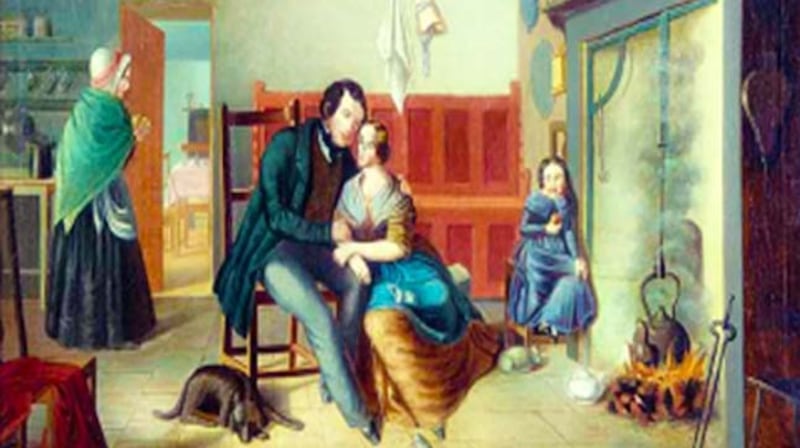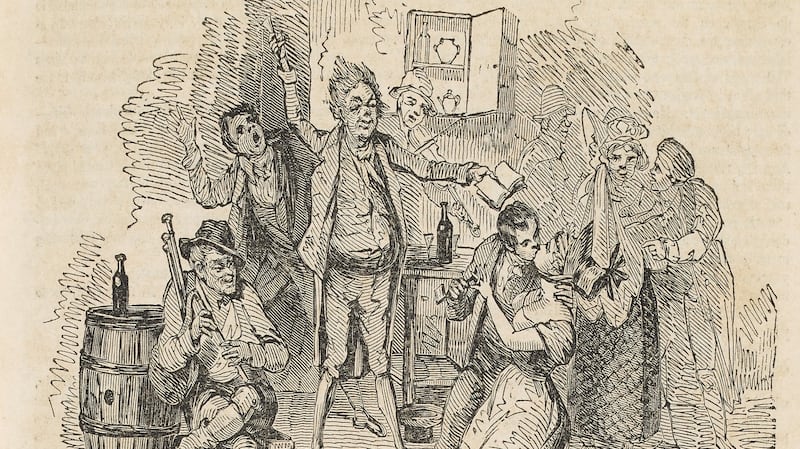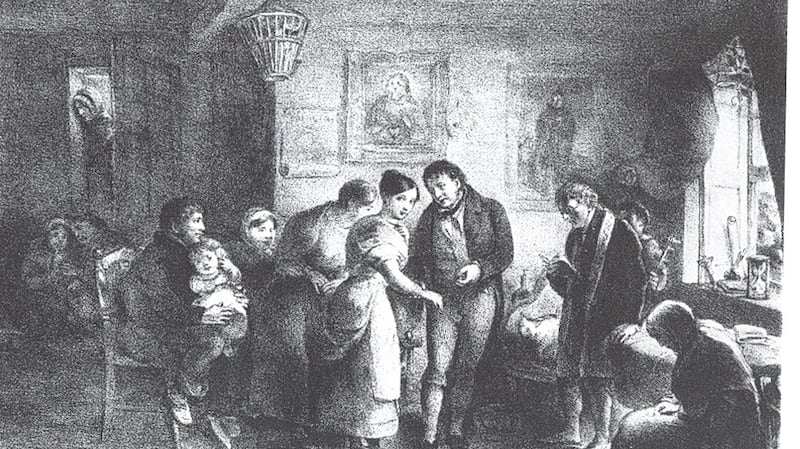In 1851, a priest wrote to Cardinal Paul Cullen about one of his parishioners, Edward Duffy, “ [Who] did not tell me the truth about sending his pretended wife away.
He has her concealed in some of his neighbour’s houses every day and they go together every night. When I can get them to live separately every night, I will inform your Grace of it. Duffy’s now pretended wife and his first wife were first cousins. To avoid scandal it might be desirable to grant them a dispensation in the above impediment in the second degree of affinity, if they separate for some time.”
Duffy, a widower, was defying the guidelines of the Catholic Church on marriage. He was cohabiting with a woman who was not his wife and he was ignoring church regulations on forming a relationship with a close family relative (which included the relatives of a dead spouse).
The Catholic Church prohibited marriage to anyone who was related going back over four generations
A popular view of Irish society in the past is that it was priest-ridden with most people concerned to follow Catholic teaching on all issues but particularly those concerned with sex and marriage. In the course of research for our new book, Marriage in Ireland, 1660-1925, however, we came across many men and women who, like Edward Duffy, pursued love and intimacy even if it meant disobeying church regulations.
The book challenges much of what we know and understand about marriage over the last three centuries.
Marriage was the most significant institution in Irish society, and one that the State and the various churches attempted to control throughout the period. A central theme in our book, however, is the way in which men and women defied church regulations and conducted their courtship and marriage in a manner that best suited them.
Until the mid-19th century, most couples were married in a private house rather than in a church; and the public proclamation of banns which announced a forthcoming marriage (and which was required by all the church authorities) was perceived as a sign that a family was too poor to pay for a licence to dispense with it.
The Catholic Church prohibited marriage to anyone who was related going back over four generations but most people, particularly in rural Ireland, chose a partner who lived in the neighbourhood and there was a good chance that their families had been linked at some stage in the recent past.
There were ways around these rules. As the priest recommended in the case of Edward Duffy, church authorities could, for a fee, issue a licence to dispense with the rules on consanguinity. Judging by the large files on dispensations in church archives, many people did just that.

Expensive business
Marriage could be an expensive business. Fees for dispensations, money for the presiding minister and a contribution to the collection for him at the wedding feast all mounted up.
The high cost of a marriage by a Catholic priest explains why so many poor people opted not to ask their local parish priest to marry them but chose instead to go to a “couple beggar”. The latter was a clergyman, usually from the Catholic or the Established Church, who had been dismissed from his clerical position for a variety of offences – often involving women and alcohol.
Although no longer based in a parish, couple beggars remained ordained ministers and they could conduct legally valid marriage services. Their low fees were an attractive option for the poor.
Marriage by a couple beggar was also appealing to those who wished to marry quickly and with few awkward questions about parental consent or the religious affiliation of the couple. For this reason, a local couple beggar was frequently summoned to preside at the forced marriage of an abducted woman.
Property and money were important features of marriage. Abductions testify to the attraction of a woman with a dowry
Joseph Wood and his wife, Jane, operated a very lucrative couple-beggar business in Smithfield market in Dublin the early 19th century. Wood, who had been ordained as a Church of Ireland minister, married hundreds of couples as well as hiring other clergymen as his business expanded.
His wife, Jane assisted him, issuing marriage certificates and acting as a witness to the service, if required. Jane, by hiring in other “couple beggars”, continued the business when her husband died
Many of the couples who visited the Woods’s “marriage house” in Smithfield did so on a whim or following an evening’s drinking. Some woke up the next morning, only dimly aware that they had been married the night before.
Wood was not legally able to dissolve the marriages that he conducted but there were claims that he or his wife would, for payment of a fee, perform a “divorce” by deleting the names from their registers or by formally tearing up the marriage certificate. In the eyes of the law, however, the couple remained married and could find themselves accused of bigamy if they married again, which some did.
Reading through the historical records available in ecclesiastical archives, it is clear too that many Irish people enjoyed pre-marital sex, engaged in adultery, made use of prostitutes and did not always much care what their neighbours or priests thought of their actions.
Bigamy trials
The records of the session meetings of the Presbyterian Church record the men and women who appeared before the church elders to confess premarital sex, extramarital affairs and bigamy.
Irish newspapers in the 18th and 19th centuries filled their pages with reports of bigamy trials, desertion of husbands and wives from their marriages, breach of promises to marry and the seduction of young women who, as a consequence, became single mothers.
The surviving historical record attests to a society where the expression of sexuality was less inhibited than has been assumed. A study of marriage and marital relationships is more than the history of a couple, it is also the history of the evolution of social and legal attempts to manage and control people’s behaviour. Many individuals and couples fought against such control.

Property and money were important features of marriage. Abductions testify to the attraction of a woman with a dowry. The actual amount given in dowries varied with the status and means of those involved and ranged from a few household items such as pots and pans and, sometimes, a bed to significant cash sums.
A parish priest in county Cork in the 1820s noted what he termed “rich farmers” giving their daughters between £100 and £300 for a dowry. In one of William Carleton’s stories, a man who has the temerity to show interest in a girl of higher social status than his own is told by her mother to go look for a girl he might “have a right to expect”, and not one that “could lay down guineas where you could hardly find shillings”.
Exploring dowries tells us a lot about how families were constructed in this period, about the use of material resources in a household, about status, about the place of women and men in households, about power relationships and, of course, about the importance and value of land in Irish farming families. Dowries could be the cause of much strife in families.
In 1874, Mary Anne McKeever brought a substantial £500 dowry to her marriage with William McKeever, a farmer with 128 acres of land, in Co Meath and £3,000 of stock. Yet, when she arrived at the farm, where she was to live with her husband and his mother, she found it “more like a barn than a house”.
Mary Anne informed the judge who presided over her judicial separation for cruelty that a few weeks after she arrived at the farm her husband declared to his relatives that he regretted the marriage due to its cost. He subsequently left their bedroom and went to sleep in the kitchen. He repeatedly asked his wife to leave and return to her uncle, with whom she previously lived, and when she refused she was violently beaten and kept with no food.
On one occasion, when she reminded him that they needed meal and other household foods, he refused to buy it saying “when you won’t earn, you won’t spend”. At the court hearing, he denied cruelty and said she was extravagant.
Meeting your match
Match-makers have a particular mythology in Ireland but such individuals appear to be a late 19th- and 20th-century phenomenon. Prior to that time, most “matches” were initiated in a carefully choreographed process by a family friend or relative who ascertained if the marriage would be acceptable to both families and then the fathers negotiated the financial terms.
In farming families the match left little room for individual choice, particularly for women. These were very formal, unromantic bargains, and when they appear in court cases, such as in breach of promise cases, barristers frequently mocked them, noting that the deal could have been that of a sale of a cow or pig.
By the end of the 19th century, men and women began to have more freedom to marry for love or, at least, to choose their marriage partner. Migration to the cities for work, the opening-up of more social spaces for sport and clubs, and improvements in travel and communication all gave young people more space to socialise away from the supervision of their families.
Marriage was 'for better or worse', for life and no reprieve was possible even in a union that both partners found unsatisfactory
In post-Famine Ireland, when suitable partners were difficult to find, some men and women began to use the new phenomenon of the personal advertisement to look for a suitable spouse.
There was a noticeable gender divide in the requirements of men and women in a potential partner. The men were usually looking for a “young lady”, “good-looking” and with “means” or a business. Others wanted a wife who could assist her husband in business.
In 1892, for example, a young Catholic draper who claimed to have £3,000 invested in his business sought a “young lady having thorough knowledge of the general Drapery and a taste for business”. He indicated that “money was no object” if a woman was “found suitable”. She must, however, be “tall, handsome and respectable”.
Most of the women who inserted notices looked for financial security rather than detailing the physical attributes of a potential partner. There appears to have been a marked preference for members of the Royal Irish Constabulary, probably because they had permanent and pensionable positions.

Attractive salary
Policemen who inserted notices were also keen to highlight their occupation. In January 1891, a head constable, aged 36 and “considered good-looking” detailed the attractions of his employment: an annual salary of £104 and £700 in the bank.
In 21st-century Ireland, we praise the new sexual freedoms of Irish society. Men and women wishing to live together may do so with or without a formal marriage service. If they opt for the former, they can choose from a wide range of religious and secular ceremonies. This is perceived as being in sharp contrast to the significance ascribed to marriage in Ireland’s past, when a religious service was deemed essential and engaging in sexual activity outside marriage was denounced as sinful by a controlling Catholic Church.
Same-sex marriage, of course, did not exist. Marriage was “for better or worse”, for life and no reprieve was possible even in a union that both partners found unsatisfactory.
Yet, we demonstrate in Marriage in Ireland, 1660-1925 that throughout the long time span covered by the book, subversive behaviour and side-stepping the laws of church and State in relation to personal and intimate relationships were common. The pursuit of love by Irish men and women, however that was understood in practical or romantic terms, their demand for personal attachment, their desire for sexual fulfilment and their assertion of economic agency challenged social norms throughout the period.
The narrowing of options for marriage and the social and legal repression of the practice of sexuality was arguably at its height from the early years of the Free State through to the 1960s. The past may be a different country but they did not always do things differently there.
Marriage in Ireland, 1660-1925 by Maria Luddy and Mary O’Dowd is published by Cambridge University Press

















